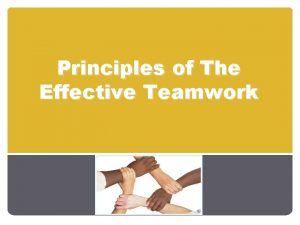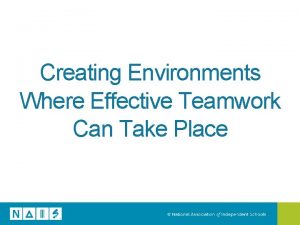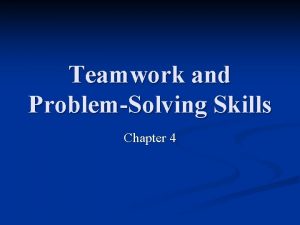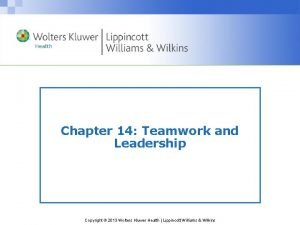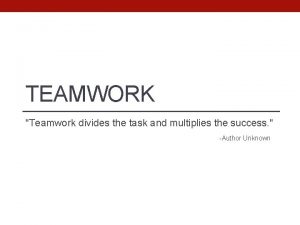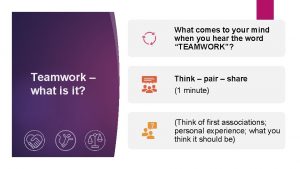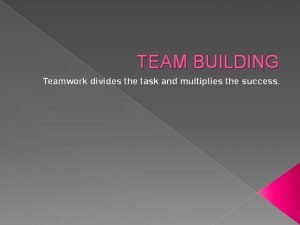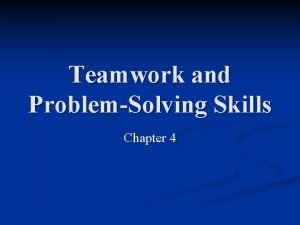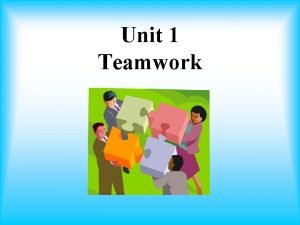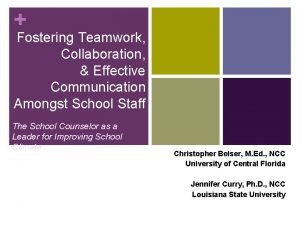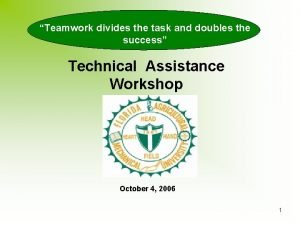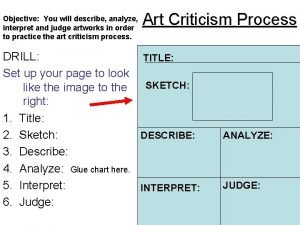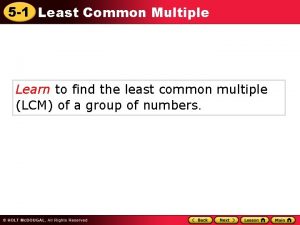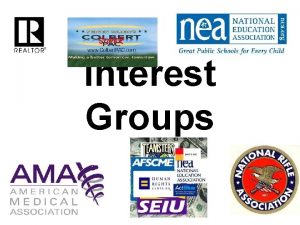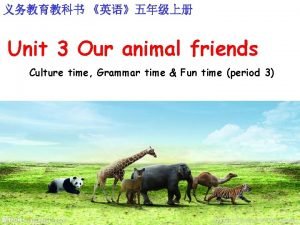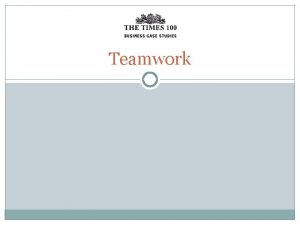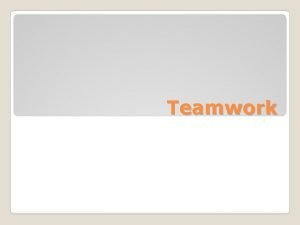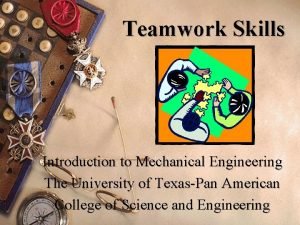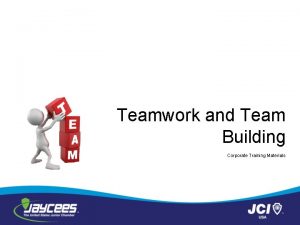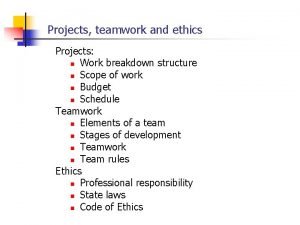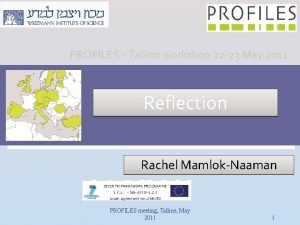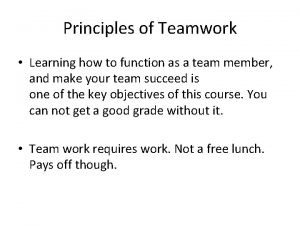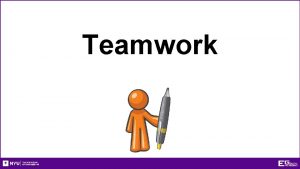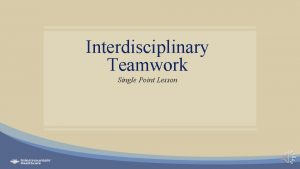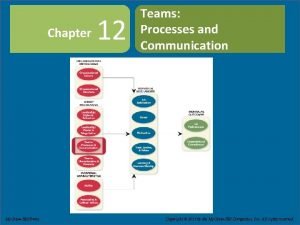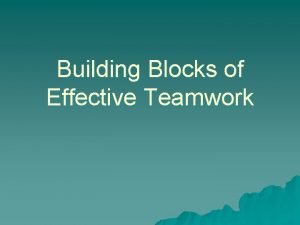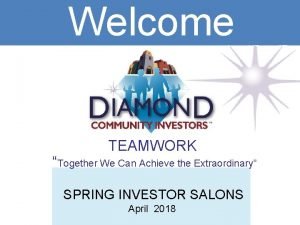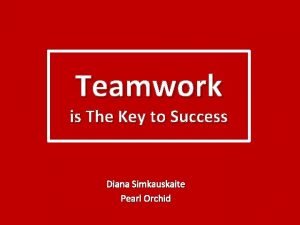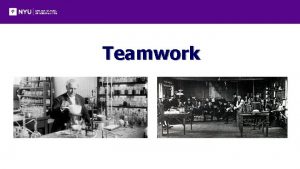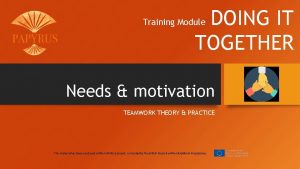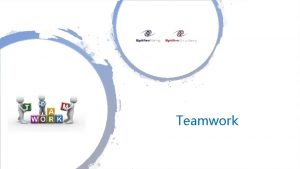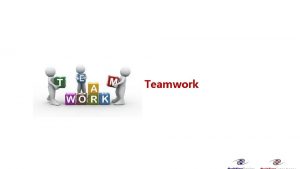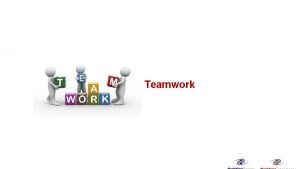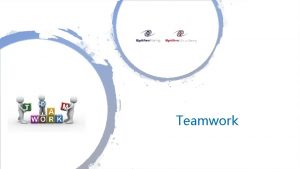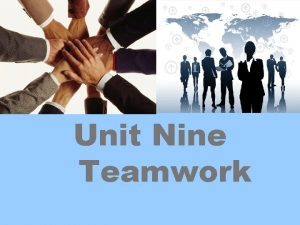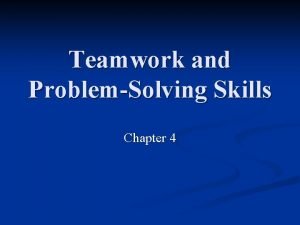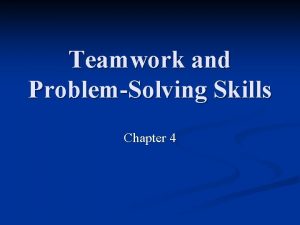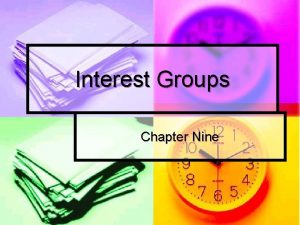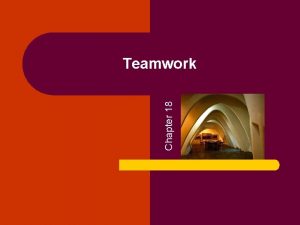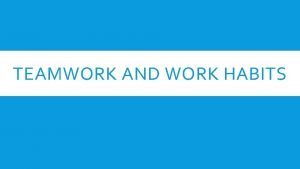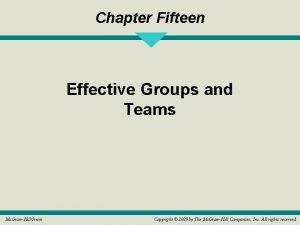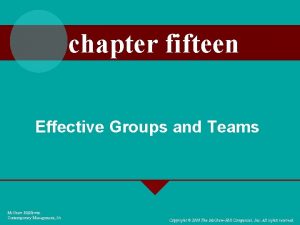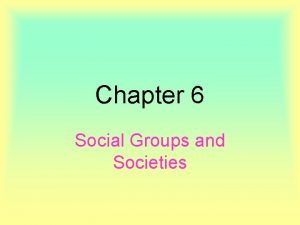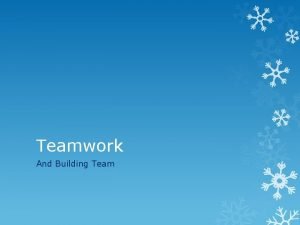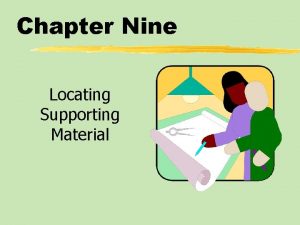Chapter Nine Effective Groups and Teamwork Mc GrawHillIrwin














































- Slides: 46

Chapter Nine Effective Groups and Teamwork Mc. Graw-Hill/Irwin Copyright © 2010 The Mc. Graw-Hill Companies, Inc. All rights reserved.

After reading the material in this chapter, you should be able to: • Describe the five stages of Tuckman’s theory of group development. • Contrast roles and norms, and specify four reasons norms are enforced in organizations. • Explain how a work group becomes a team, and identify five teamwork competencies. • List at least four things managers can do to build trust. • Describe self-managed teams and virtual teams. • Describe groupthink, and identify at least four of its symptoms. 9 -2

Fundamentals of Group Behavior • Group - two or more freely interacting people with shared norms and goals and a common identity 9 -3

Formal and Informal Groups • Formal group - formed by the organization. • Informal group - formed by friends 9 -4

Formal Groups Fulfill Organizational and Individual Functions Table 9 -1 9 -5

Tuckman’s Five-Stage Theory of Group Development Figure 9 -1 9 -6

Group Development Process Stage 1: Forming • Group members tend to be uncertain and anxious about their roles, the people in charge and the group’s goals • Mutual trust is low 9 -7

Group Development Process Stage 2: Storming • Time of testing • Individuals try to determine how they fit into the power structure • Procrastination may occur 9 -8

Group Development Process Stage 3: Norming • Questions about authority and power are resolved through unemotional, matter-offact group discussion • Group cohesiveness - a “we feeling” binding group members together 9 -9

Question? A search committee has been created at ABC University to hire a new dean of College of Business. During which stage of the group development process would the search committee address role agreements and working as a team? A. B. C. D. Storming Performing Adjourning Norming 9 -10

Group Development Process Stage 4: Performing • Activity focused on solving task problems • Climate of open communication, strong cooperation, and lots of helping behavior 9 -11

Group Development Process Stage 5: Adjourning • Work is done • Time to move on to other things 9 -12

Group Member Roles • Roles - expected behaviors for a given position • Task roles - task-oriented group behavior - Keep the group on track • Maintenance roles - relationship-building group behavior - Keep the group together 9 -13

Task and Maintenance Roles 9 -14

Question? Bob's role in his work group is to promote greater understanding through examples or explanation of implications. Bob's role can be described as a(n): A. B. C. D. Initiator Elaborator Coordinator Energizer 9 -15

Norms • Norms - shared attitudes, opinions, feelings, or actions that guide social behavior • Ostracism - rejection by other group members 9 -16

How Norms are Developed 1. Explicit statements by supervisors or coworkers 2. Critical events in the group’s history 3. Primacy 4. Carryover behaviors from past situations 9 -17

Why Norms are Enforced • Help the group or organization survive • Clarify or simplify behavioral expectations • Help individuals avoid embarrassing situations • Clarify the group’s or organization’s central values and/or unique identity 9 -18

Teams • Team - small group with complementary skills who hold themselves mutually accountable for common purpose, goals, and approach. - Task groups that have matured to the performing stage 9 -19

Teams A group becomes a team when: 1. Leadership becomes a shared activity 2. Accountability shifts from strictly individual to both individual and collective 3. The group develops its own purpose or mission 4. Problem solving becomes a way of life, not a part-time activity 9 -20

Team Building • Team building - experiential learning aimed at better internal functioning of groups 9 -21

Question? As the new Department Chair, Melvin wanted his faculty members to engage in more collaboration. He decided to start by taking everyone to a Paintball course. This is called ______. A. B. C. D. Social loafing Cohesiveness Team building Leadership 9 -22

Trust • Trust - reciprocal faith in other’ intentions and behavior. 9 -23

Three Dimensions of Trust • Overall trust - expecting fair play, the truth, and empathy • Emotional trust - having faith that someone will not misrepresent you to others or betray you 9 -24

Three Dimensions of Trust (cont. ) • Reliableness - believing that promises and appointments will be kept and commitments met 9 -25

How to Build Trust 1. 2. 3. 4. 5. 6. Communication Support Respect Fairness Predictability Competence 9 -26

Question? As quarterback at Alabama, Jay Barker won almost all of the games he started. When the team was in a tough situation, they trusted Barker to help them win. The team’s trust was built by Barker’s _______. A. B. C. D. Respect Fairness Predictability Competence 9 -27

Self-Managed Teams • Self-managed teams - groups of employees granted administrative oversight for their work 9 -28

Indirect Influence Tactics of Self Managed Teams • Relating • Scouting • Persuading • Empowering 9 -29

Teams • Cross-functionalism - team made up of technical specialists from different areas 9 -30

Question? The work team at More 4 Babies, Inc. is made up of technical specialists from different areas of the company. This feature of the work team at More 4 Babies is referred to as A. B. C. D. Cross-functionalism. Administrative alignment. Cohesiveness. Groupthink. 9 -31

Are Self Managed Teams Effective? • Have a positive effect on productivity • Have a positive effect on specific attitudes relating to self-management • No significant effect on general attitudes • No significant effect on absenteeism or turnover 9 -32

Virtual Teams • Virtual team - allows group members in different locations using information technology to conduct business. 9 -33

Research Insights • Virtual groups formed over the Internet follow a group development process similar to that of face-to-face groups - Meaningful face-to-face contact during early phases of group development process is essential • Internet chat rooms create more work and yield poorer decisions than face-to-face meetings 9 -34

Threats to Group and Team Effectiveness • Groupthink - Janis’s term for cohesive in-group’s unwillingness to realistically view alternatives. Read an article on groupthink 9 -35

Symptoms of Groupthink • Invulnerability • Inherent morality • Rationalization • Stereotyped views of opposition • Self-censorship • Illusion of unanimity • Peer pressure • Mindguards 9 -36

Social Loafing • Social Loafing - decrease in individual effort as group size increases 9 -37

Reasons for Social Loafing • Equity of effort • Loss of personal accountability • Motivational loss due to sharing of rewards • Coordination loss as more people perform the task 9 -38

Question? The Principles of Management class has a project that counts for 50% of the class grade. Groups of 10 have been assigned to complete it. Duane thinks that he will not have to work very hard because the group is so large. This is called _______. A. Groupthink B. Cohesiveness C. Social loafing D. Collective groupthink 9 -39

Supplemental Slides • Slides 41 -46 contain extra non-text examples to integrate and enhance instructor lectures - Slide 41: Recent Research on Trust Slide 42: Management in the Movies: 13 Going on 30 Slide 43: Virtual Teams Slide 44: Tips for Working on Virtual Teams Slide 45 -46: Video discussion slides 9 -40

Recent Research on Trust • Schweitzer, Hershey, and Bradlow (2006) – conducted laboratory study and found…. . - When trust is broken by untrustworthy actions, it can be restored through consistent trustworthy actions - A promise to act in a trustworthy way helps facilitate the regaining of trust - Deception does serious long-term damage to trust and makes it very difficult to restore, even when followed by trustworthy actions 9 -41

Management in the Movies 13 Going on 30 • In this scene, Jenna is at a Poise magazine party. • How does the group on the dance floor move through the stages of group development? • What type of group is the dance floor group? 9 -42

Virtual Teams – Quotes from the Front Line • “Since I don’t know those people in [other cities], getting their stuff done is a low priority. My priorities are about things that are in my face, like when people I see every day are standing there looking at me, waiting for me to get their stuff done. ” • “Everybody is so busy that you know they’re all multitasking during the call. When I’m the one leading a meeting, I’m pretty sure half of them are checking their e-mails. Nobody pays much attention. ” 9 -43

Tips for Working on Virtual Teams • Meet face-to-face to start a project and for major milestones • Assume positive intent - If an e-mail's tone sounds off-putting, withhold judgment until you learn more or talk to them directly via phone • Engage in positive predictable behavior - Honor commitments, attend meetings on time, don’t send terse emails 9 -44

Video Case: United Airlines Employees Learn from Nascar • What types of things can a ground crew member working for an airline company learn from a NASCAR pit crew? • Why are the lessons learned from Pit Crew U so universally applicable across many jobs and industries? • How could United justify the costs of sending 1200 employees to Pit Crew U - will they save that much time? • What is United’s goal in sending the employees to Pit Crew U? 9 -45

Video Case: Teamwork: Team Activities for Coworkers • What types of activities are being used today for team building and skills development? Why do these types of activities work? • Are companies able to justify sending employees to fun training programs? How? • Are corporate training programs such as those described in the video case growing in popularity? • What benefits do you think you would get from attending training programs like those described in the case? 9 -46
 Short tube or stick carried in relay race
Short tube or stick carried in relay race Principles of teamwork
Principles of teamwork Effective teamwork
Effective teamwork How are ethnic groups and religious groups related
How are ethnic groups and religious groups related Teamwork problem solving
Teamwork problem solving Chapter 14 teamwork and leadership
Chapter 14 teamwork and leadership Teamwork divides the task and multiplies the success
Teamwork divides the task and multiplies the success Qsen core competencies
Qsen core competencies What comes to your mind when you hear the words work
What comes to your mind when you hear the words work Teamwork divides the task and multiplies the success
Teamwork divides the task and multiplies the success Teamwork
Teamwork Teamwork and problem solving terms
Teamwork and problem solving terms Teamwork and collaboration vocabulary
Teamwork and collaboration vocabulary Qsen teamwork and collaboration
Qsen teamwork and collaboration Fostering teamwork
Fostering teamwork Teamwork divides the task and doubles the success
Teamwork divides the task and doubles the success What does it describe
What does it describe Disadvantages of gagne's instructional events
Disadvantages of gagne's instructional events There were ninety and nine
There were ninety and nine Least common multiple of 2 and 5
Least common multiple of 2 and 5 Fallen cherub to be weak is miserable
Fallen cherub to be weak is miserable The new deal affects many groups
The new deal affects many groups For or against
For or against Chapter 10 comparing two populations or groups crossword
Chapter 10 comparing two populations or groups crossword Chapter 9 section 2 types of interest groups
Chapter 9 section 2 types of interest groups Chapter 17 section 3 mixed groups
Chapter 17 section 3 mixed groups Chapter 10 comparing two populations or groups
Chapter 10 comparing two populations or groups Work ethics for work immersion
Work ethics for work immersion Conflict resolution work immersion
Conflict resolution work immersion Teamwork animals working together
Teamwork animals working together Motivational speech on teamwork
Motivational speech on teamwork Facilitate teamwork
Facilitate teamwork Teamwork in engineering
Teamwork in engineering Teamwork training material
Teamwork training material Learning objectives for teamwork
Learning objectives for teamwork Teamwork in work ethics
Teamwork in work ethics Work reflections for meetings
Work reflections for meetings Principles of teamwork
Principles of teamwork How do different personalities affect teamwork
How do different personalities affect teamwork Engineering teamwork
Engineering teamwork Single point lesson
Single point lesson Teamwork processes
Teamwork processes Teamwork u
Teamwork u Thanks for teamwork
Thanks for teamwork Teamwork is the key to success
Teamwork is the key to success Elon musk teamwork
Elon musk teamwork Motivation training module
Motivation training module

